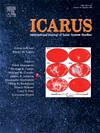Love numbers for Io with a magma ocean
IF 2.5
2区 物理与天体物理
Q2 ASTRONOMY & ASTROPHYSICS
引用次数: 0
Abstract
The volcanic activity of Jupiter’s moon Io is driven by the heat generated by tidal deformation induced by its orbital resonance with Europa and Ganymede. The question of whether tidal dissipation primarily occurs in a partially molten solid layer (“magmatic sponge”) or in a hypothetical liquid magma ocean has long been a subject of debate. The data collected by the Juno spacecraft during two recent flybys of Io has allowed, for the first time, to quantify Io’s tidal deformation. The analysis of the data by Park et al. (2024) reveals that the Love number is about 0.125 and the tidal dissipation parameter is about 11.4. These values are compatible with a solid mantle but they do not exclude the possibility that a global magma ocean exists in the deep (320 km) interior. Using a model based on the solution of the Navier–Stokes equation, we investigate the dependence of the Love number on the position of the ocean and examine how much it is affected by the Coriolis force, an effect that was not included in the study of Park et al. (2024). Varying the viscosity of the magma, the depth and the thickness of the ocean in the range of – Pa s, 50–400 km and 0.1–20 km, respectively, and considering only the models with a dissipation power of about 100 TW, we show that a magma ocean located at a depth of km predicts either too large or too long time lag, implying that the existence of a shallow magma ocean in Io is unlikely. A thin (10 km) magma ocean located at a depth of km is compatible with the observation and could, in principle, be detected by accurate measurement of degree 2 zonal and sectorial Love numbers. Our results are in general agreement with those of Park et al. (2024), indicating that Io’s enormous volcanic activity is unlikely to be driven by a global fluid magma ocean located at a shallow depth. This conclusion is conditioned by the reliability of the method used to interpret the Juno data. As the tidal response of Io with a magma ocean is affected by the Coriolis force, the Love number depends on the harmonic order, which can complicate the analysis of the information collected during the flybys. The effect of fluid tides was not considered in the data processing, and therefore, the conclusions of Park et al. (2024) cannot be definitely confirmed.
爱的数字为木卫一岩浆海洋
木星卫星木卫一的火山活动是由其与木卫二和木卫三的轨道共振引起的潮汐变形所产生的热量驱动的。长期以来,潮汐消散主要发生在部分熔融的固体层("岩浆海绵")还是假定的液态岩浆海洋中一直是一个争论不休的问题。朱诺号航天器最近两次飞越木卫二时收集到的数据首次对木卫二的潮汐变形进行了量化。Park 等人(2024 年)对数据的分析表明,洛夫数 k2 约为 0.125,潮汐耗散参数 Q 约为 11.4。这些数值与固体地幔相吻合,但并不排除内部深部(320 千米)存在全球岩浆洋的可能性。利用基于纳维-斯托克斯方程求解的模型,我们研究了洛夫数对海洋位置的依赖性,并考察了它受科里奥利力影响的程度,Park 等人(2024 年)的研究没有包括科里奥利力的影响。在岩浆粘度、岩浆洋深度和厚度分别为102-107帕秒、50-400千米和0.1-20千米的范围内改变岩浆粘度、岩浆洋深度和厚度,并只考虑耗散功率约为100太瓦的模型,我们发现位于≲200千米深度的岩浆洋预测的k2过大或时滞过长,这意味着木卫二不太可能存在浅岩浆洋。位于≲250千米深处的薄岩浆洋(10千米)与观测结果相符,原则上可以通过精确测量2度的带状和扇形爱数来探测。我们的结果与 Park 等人(2024 年)的结果基本一致,表明木卫二巨大的火山活动不太可能是由位于浅层的全球流体岩浆海洋驱动的。这一结论取决于解读朱诺数据的方法是否可靠。由于具有岩浆海洋的木卫二的潮汐反应受到科里奥利力的影响,爱数取决于谐波阶数,这可能会使飞越期间收集的信息分析复杂化。在数据处理过程中没有考虑到流体潮汐的影响,因此,Park 等人(2024 年)的结论无法得到肯定的证实。
本文章由计算机程序翻译,如有差异,请以英文原文为准。
求助全文
约1分钟内获得全文
求助全文
来源期刊

Icarus
地学天文-天文与天体物理
CiteScore
6.30
自引率
18.80%
发文量
356
审稿时长
2-4 weeks
期刊介绍:
Icarus is devoted to the publication of original contributions in the field of Solar System studies. Manuscripts reporting the results of new research - observational, experimental, or theoretical - concerning the astronomy, geology, meteorology, physics, chemistry, biology, and other scientific aspects of our Solar System or extrasolar systems are welcome. The journal generally does not publish papers devoted exclusively to the Sun, the Earth, celestial mechanics, meteoritics, or astrophysics. Icarus does not publish papers that provide "improved" versions of Bode''s law, or other numerical relations, without a sound physical basis. Icarus does not publish meeting announcements or general notices. Reviews, historical papers, and manuscripts describing spacecraft instrumentation may be considered, but only with prior approval of the editor. An entire issue of the journal is occasionally devoted to a single subject, usually arising from a conference on the same topic. The language of publication is English. American or British usage is accepted, but not a mixture of these.
 求助内容:
求助内容: 应助结果提醒方式:
应助结果提醒方式:


